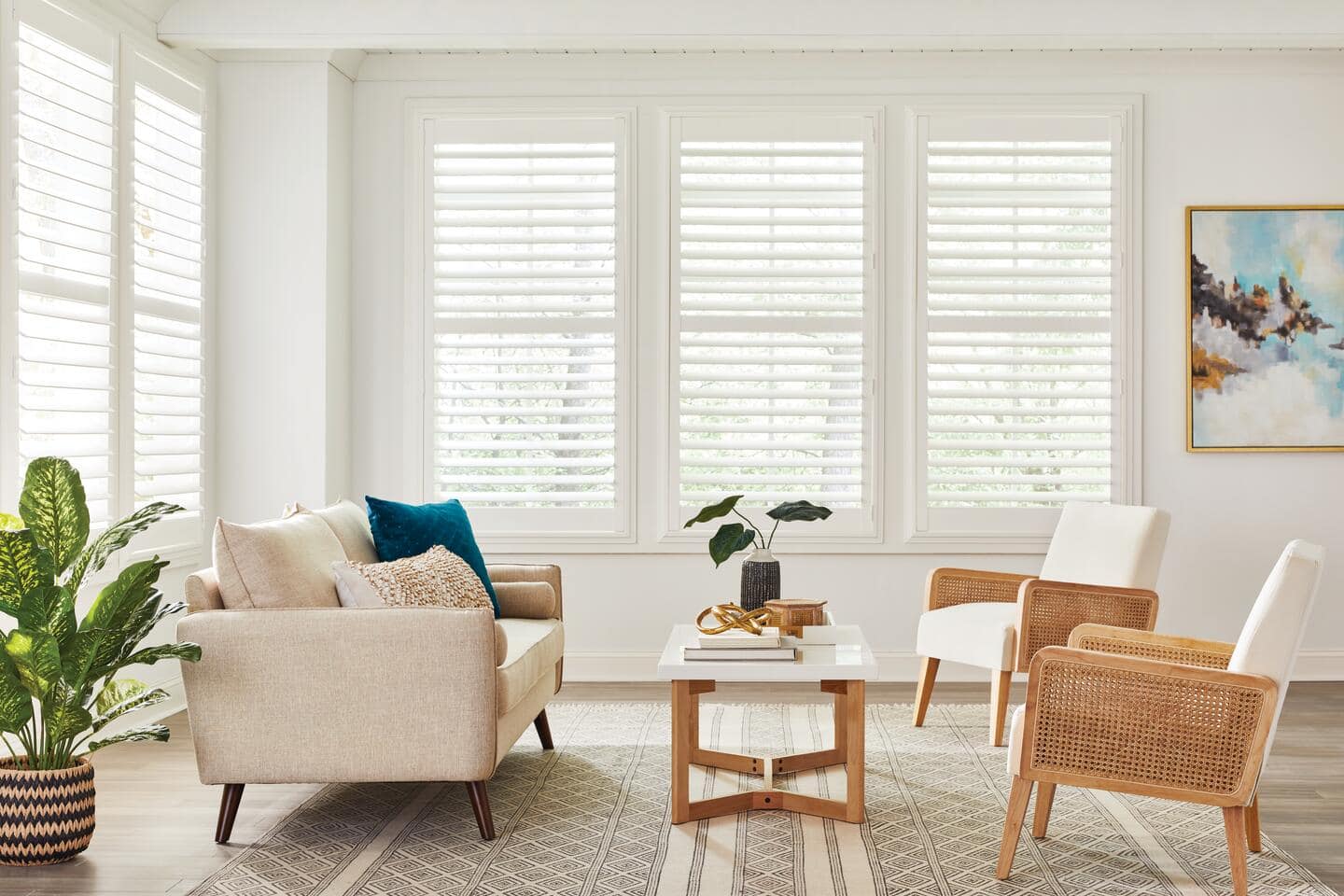Are you overwhelmed by the choices available when buying plantation shutters?
With so many styles, materials, and features to consider, it’s easy to feel lost and unsure about making the right decision for your home.
Our Beginner’s Guide to Plantation Shutters offers a complete shopper’s checklist, breaking down everything you need to know to make an informed and confident purchase.
1. Measuring Your Windows
Accurate measurements ensure your plantation shutters fit perfectly and function properly. Here’s a step-by-step guide to help you measure your windows with precision.
First, determine whether you want an inside mount or an outside mount. For inside mounts, measure the width and height of the window recess at three points: top, middle, and bottom for width; left, centre, and suitable for height.
Use the smallest measurements to ensure a snug fit. For outside mounts, measure the width and height of the window frame, adding extra space for the shutter frame to overlap.
Depending on your preference and the shutter style, this overlap typically ranges from 5 to 7 centimetres on each side.
Ensure you use a steel tape measure for accuracy and note your measurements in millimetres for precision.
Check for any obstructions, such as window handles or locks that might affect the installation. If your windows are not perfectly square, consider using a shimming technique or custom-made shutters to ensure a proper fit.
2. Choosing the Right Material
Selecting the suitable material for your plantation shutters is essential for ensuring durability, aesthetics, and functionality. Each material offers distinct benefits that cater to different needs and environments.
Wooden shutters are renowned for their classic and elegant appearance. They provide a warm, natural look and can be customised with various stains and finishes to match your interior decor.
However, they require more maintenance and can be susceptible to moisture and humidity, making them less suitable for bathrooms and kitchens.
Faux wood shutters, made from composite materials, offer the aesthetic appeal of natural wood but with enhanced durability.
They are resistant to moisture and humidity, making them ideal for high-moisture areas like bathrooms and kitchens. They are also easier to maintain and clean compared to wooden shutters.
Vinyl shutters are the most cost-effective option. They are incredibly durable, easy to clean, and moisture-resistant, making them perfect for any room in the house. However, they might not have the same refined appearance as wood or faux wood shutters.
When choosing the material, consider the room’s environment, your budget, and the desired aesthetic. Understanding these factors will help you select the material that best meets your needs, ensuring your plantation shutters are both beautiful and practical.
3. Selecting the Louver Size
Choosing the right louvre size for your plantation shutters is crucial for balancing light control, privacy, and aesthetic appeal. Each size offers distinct benefits that can enhance the functionality and look of your shutters.
Smaller louvres provide a more traditional and classic appearance. They are ideal for smaller windows or rooms with a more delicate and detailed look.
These louvres can create a cosy atmosphere but may limit the light entering the room and the outside view, making them less suitable for spaces where you desire ample natural light and a wide view.
Medium-sized louvres strike a balance between traditional and modern styles. They offer reasonable light control and visibility while maintaining a classic appearance.
These versatile louvres work well in various room sizes and styles, providing sufficient light and privacy control without overwhelming the space.
Larger louvres are perfect for a contemporary and spacious look. They provide the best visibility and maximum light control, making them ideal for more oversized windows and rooms where you want an unobstructed view and plenty of natural light.
These louvres can make a room feel more open and airy but may look out of place in smaller, more traditional settings.
When selecting the louvre size, consider your room’s size, window dimensions, and desired aesthetic.
Larger louvres are excellent for open, modern spaces, allowing more light and a clearer view. They are particularly effective in living rooms and dining areas.
Smaller louvres suit more traditional, cosy settings, such as bedrooms or study rooms, where privacy and a classic look are prioritised.
4. Customisation Options
Plantation shutters offer a wide range of customisation options, allowing you to create a look that perfectly suits your home’s decor and style.
Understanding these options will help you make informed decisions to achieve the desired aesthetic and functionality.
Wood, faux wood, and vinyl are popular materials, each offering different durability, maintenance, and appearance benefits.
The colour and finish options are extensive, from classic whites and neutrals to bold, custom colours. This flexibility ensures that your shutters can seamlessly blend with or stand out against your existing decor.
Louvre sizes vary, allowing you to control light and privacy levels. Tilt options include the traditional tilt rod, which runs down the centre of the shutter, and hidden tilt, which offers a cleaner, more modern look by positioning the tilt mechanism out of sight.
Additionally, you can choose between inside or outside mounts to achieve the desired fit and appearance.
5. Budgeting for Plantation Shutters
Budgeting for plantation shutters involves considering several factors to ensure you get the best value for your investment without compromising quality and aesthetics.
Here’s a detailed breakdown to help you plan your budget effectively.
- Material costs are a primary consideration. Wooden shutters are typically more expensive due to their premium look and customisation options. Faux wood shutters offer a middle ground, providing the wood look with added durability and moisture resistance at a slightly lower cost. Vinyl shutters are the most cost-effective, offering durability and ease of maintenance but with a less refined appearance.
- Customisation options can also impact your budget. Special finishes, custom colours, and unique louvre sizes may increase costs. Opting for hidden tilt mechanisms or motorised controls can add to the expense but offer enhanced functionality and a sleeker look.
- Installation costs should also be factored in. While some homeowners may choose DIY installation to save money, professional installation ensures a perfect fit and can prevent potential issues.
- Maintenance and repair costs: High-quality shutters may have a higher upfront cost but often require less maintenance and have a longer lifespan, providing better long-term value.
6. Installation Process
Installing plantation shutters correctly is crucial for their functionality and aesthetic appeal.
Here’s a detailed step-by-step guide to help you understand the process.
1. Preparation
Before you begin, ensure accurate window measurements, considering whether you opt for an inside or outside mount. Gather all necessary tools, including a drill, screws, level, measuring tape, and a screwdriver. Ensure you have a clean, clear workspace to lay out the shutters and frames.
2. Mounting frames
For inside mounts, position the frame inside the window recess. Check that it is level and square using a spirit level.
Mark the screw holes with a pencil, then drill pilot holes to prevent the wood from splitting. Secure the frame with screws, ensuring it remains level throughout the process.
For outside mounts, place the frame on the wall around the window. Ensure it’s centred and level, then mark, drill, and screw in place. The outside mount will typically require more support, so ensure it’s firmly attached to the wall.
3. Attaching the panels
Once the frame is secure, attach the shutter panels using the provided hinges. Start by attaching the hinges to the panels first, then to the frame.
Ensure the panels are level and can open and close smoothly. It’s helpful to have an extra pair of hands to hold the panels in place while you secure the hinges.
Adjust the hinges if necessary to achieve a perfect fit and ensure even spacing between panels.
4. Final adjustments
Check that the louvres open and close correctly and that there are no gaps between the panels and the frame.
Adjust the tilt mechanism to ensure smooth operation. Tighten all screws securely and double-check that everything is level and aligned.
If your shutters have a magnetic catch or other closing mechanism, ensure they are aligned and function properly.
5. Professional installation
A professional installer will have the experience and tools to ensure a perfect fit and avoid potential issues arising from incorrect installation.
This can save you time and ensure the longevity and performance of your shutters.
Maintenance and Care
Proper maintenance and care are essential to keep your plantation shutters looking their best and functioning smoothly for years.
Here’s a detailed guide to help you maintain and care for your shutters:
- Regular Dusting: Use a soft, dry cloth or a feather duster to remove dust from the louvres and frames. Regular dusting prevents the build-up of grime and keeps your shutters looking fresh. For deeper cleaning, use a vacuum cleaner with a brush attachment to reach into crevices and between louvres. This is particularly useful for removing dust in hard-to-reach areas.
- Spot Cleaning: Dampen a cloth with mild soap and water, then gently wipe the affected area. This method effectively removes dirt and minor stains without damaging the shutters. Avoid using harsh chemicals or abrasive cleaners to prevent damage to the shutter finish. These substances can strip the paint or protective coating, leading to premature wear.
- Lubricating Hinges: Apply a small amount of silicone-based lubricant to the hinges to prevent squeaking and ensure easy movement of the panels. Regular lubrication maintains smooth operation and extends the life of the hinges.
- Inspecting for Damage: Check periodically for signs of wear, such as loose screws, chipped paint, or cracked louvres. Early detection allows for timely repairs, preventing minor issues from becoming major problems. Tighten any loose screws and touch up paint as needed to prevent further damage. Regular maintenance keeps your shutters secure and looking their best.
- Avoiding Excessive Moisture: To reduce moisture levels, use exhaust fans in high-humidity areas like bathrooms and kitchens. Excessive moisture can cause wood shutters to warp and damage the finish. To prevent warping and damage, keep wooden shutters dry. Place them away from direct water sources and control the humidity levels in your home. Regular cleaning is usually sufficient to maintain the appearance of faux wood and vinyl shutters. These materials are more resistant to moisture but still benefit from routine care.
- Protecting from Direct Sunlight: Prolonged exposure to direct sunlight can cause fading and discolouration. Use curtains or UV-protective films on windows to shield shutters from intense sunlight. Consider rotating or adjusting louvres regularly to ensure even exposure and prevent one side from fading more than the other.
- Cleaning Hardware: Wipe down metal components such as hinges and locks with a damp cloth to remove dust and grime. This helps prevent rust and maintains the hardware’s functionality. Use appropriate metal polish for stainless steel or brass hardware to keep them shining and tarnish-free.
- Seasonal Deep Cleaning: Perform a deep cleaning at least twice a year. Remove the shutters from their frames (if possible) and clean all components thoroughly. Check for any hidden damage or wear during this deep cleaning process to address any issues promptly.
Conclusion
In conclusion, choosing the right plantation shutters involves carefully considering materials, louvre sizes, customisation options, and installation. With this guide, you’re now equipped to make an informed decision. Explore our recommended retailers and start your journey to stylish, functional shutters today!


